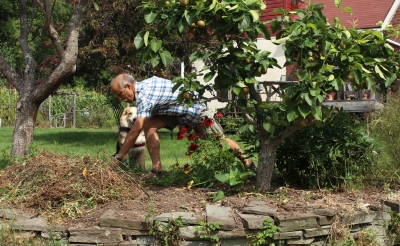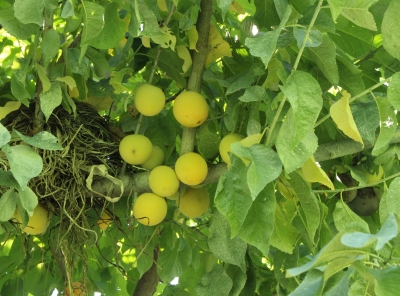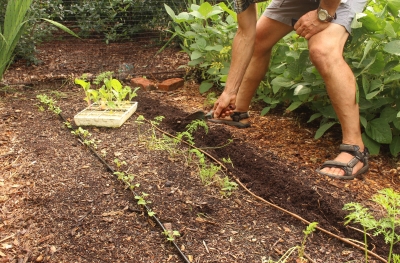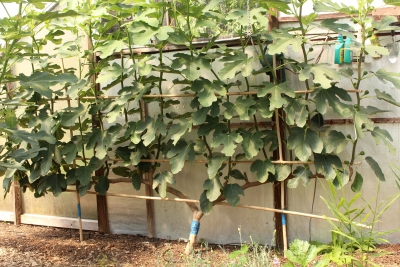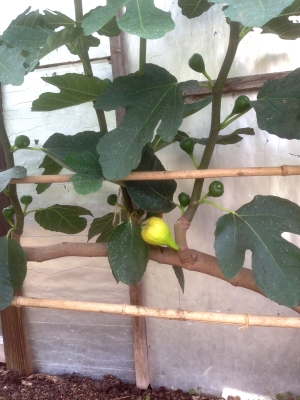MAYPOP & ASPARAGUS, BEAUTIFUL & EDIBLE
/22 Comments/in Design, Flowers, Fruit, Gardening/by Lee ReichAwesome, Made More So
You would think — or I, at least, would think — that a purple and white passionflower would be more passion-inducing than one that was merely white. Not so. The white one displays a passionate juxtaposition between a pure, lily-whiteness and a wildness from the the squiggly, threadlxike rays of its corona backdropping female stigmas’ that arch over the yellow pollen-dusted anthers.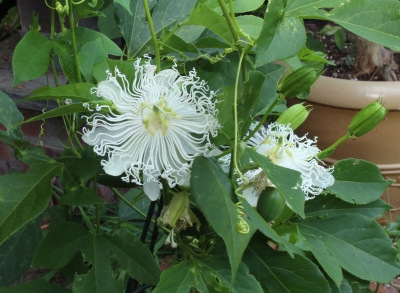
A white passionflower is a rarity. Mine sprung up by chance from a batch of seeds I planted last year. Mostly the plants bear purple and white flowers.
Most passionflowers are tropical, but this white-flowered passionflower, like its mother and siblings can survive outdoors even with our winter lows of well below zero degrees Fahrenheit. Commonly known as maypop, Passiflora incarnata is native to eastern U.S. as far north as Pennsylvania. Tropical passionflowers, are woody perennial vines; maypop is an herbaceous perennial vine, dying back to the ground each fall, but sprouting each spring from its perennial roots.
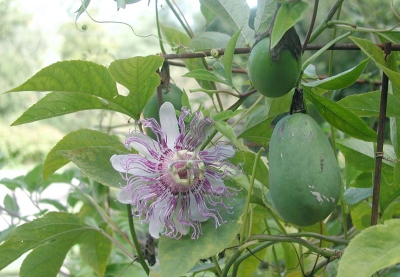 Vine growth begins late, typically not showing until early June here in the Hudson Valley. Summer warmth coaxes it along to begin flowering in July. Once the flowers appear, they continue almost nonstop through the summer until fall, with one to a few new flowers opening each day.
Vine growth begins late, typically not showing until early June here in the Hudson Valley. Summer warmth coaxes it along to begin flowering in July. Once the flowers appear, they continue almost nonstop through the summer until fall, with one to a few new flowers opening each day.
Fruits soon follow the flowers. Yes: Fruits! Passionfruits are delicious, and maypop fruits taste pretty much the same as tropical passionfruits — the main flavor in Hawaiian punch, in case you think you’re unfamiliar with the fruit. The fruit is egg-shaped, its interior packed full of seeds, each of which is surrounded by a thick coat of deliciousness, in much the same way as pomegranate seeds.
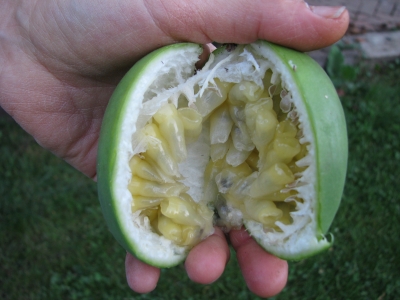 I haven’t figured out where to plant my maypops, so they’re still in large pots. Years ago, I had a couple in the ground at the base of a lilac tree. The maypops climbed into the lilac to put on a show through summer, after the lilac itself was no longer interesting. Now I want a fence for it to clothe in a heat-capturing spot in full sunlight. Maypop does spread underground, to the extent that it’s considered a weed in the Deep South, where it really can run wild. Spread is less here, but still, I need a location for it that takes that potential into account. Alternatively, I’ll plant it in a deep, bottomless container, such as a chimney flue.
I haven’t figured out where to plant my maypops, so they’re still in large pots. Years ago, I had a couple in the ground at the base of a lilac tree. The maypops climbed into the lilac to put on a show through summer, after the lilac itself was no longer interesting. Now I want a fence for it to clothe in a heat-capturing spot in full sunlight. Maypop does spread underground, to the extent that it’s considered a weed in the Deep South, where it really can run wild. Spread is less here, but still, I need a location for it that takes that potential into account. Alternatively, I’ll plant it in a deep, bottomless container, such as a chimney flue.
The Other Kind of Passion
If truth be told, the “passion” that gave passionflowers their name refers to a religious passion, the passion of Christ. The plant was a seventeenth-century teaching tool for spreading the gospel.
Passionflower “had clearly been designed by the Great Creator that it might, in due time, assist in the conversion of the heathen among which it grows,” wrote a Christian scholar of the seventeenth century. The ten so-called petals (botanically, five petals and five petal-like sepals) were taken to represent the ten apostles present at the crucifixion. The threadlike rays of the corona were taken for symbols of the crown of thorns. The five stamens and three styles referred, respectively, to the five wounds of Christ and the three nails used in the crucifixion. Even the rest of the plant figures in, with the three-lobed leaves representing the Trinity and the tendrils representing the scourges. 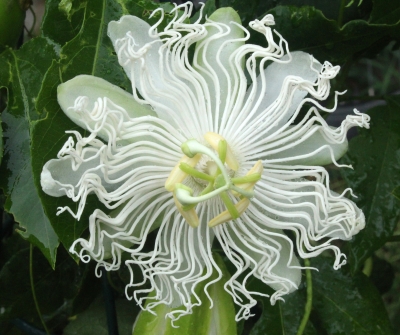
Passionflowers are heavenly enough to bring on a religious devotion to growing the plants. Which brings us to sex . . . The flowers are andromonoecious, which means that on every plant some flowers are perfect (have functioning male and female flower parts) and some are functionally male. Functional males have female parts but are functionally male either because their stigmas are held upwards out of the way of insect visitors or because their female parts are atrophied. So grow two plants if insects are to do your bidding, one plant if you’ll take care of pollination.
See my book Uncommon Fruits for Every Garden for more — a whole chapter! — on hardy passionfruits.
“Sparrowgrass” Need Help
My asparagus is now a six-foot-high, ferny hedge outside and along the eastern edge of one of the vegetable gardens. It’s a pretty sight until my eyes drop downward to see the weeds sprouting at the “hedge’s” feet. Not that the weeds are putting the brakes on the asparagus, but they are making seeds that then spread into the vegetable garden.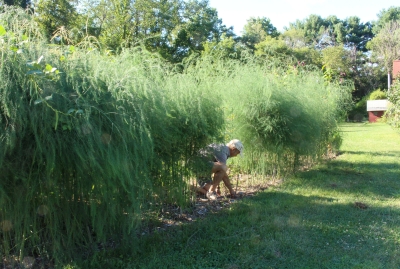
I’ve seen gardens and farms where asparagus beds were abandoned because of weeds. Mulching and early season weeding only go so far.
The usual recommendation for growing asparagus is to purchase roots and plant them at the bottom of a deep trench. As new shoots grow, the trench is gradually filled in with soil.
More recent research showed that such heroic efforts were unnecessary. I planted my asparagus just deep enough to get them into the ground.
The reason for trenching asparagus was to get the crowns low enough so that a tiller or hoe could be used to kill weeds without damaging the crown. All of which is impossible when the crowns are planted with their buds just beneath the surface.
So these days I’m periodically crawling into the hedge, becoming very intimate with the ground there, and pulling out all the weeds.
SUNNY DAYS & YOGA, BUT TOMATOES?
/5 Comments/in Fruit, Gardening, Pests, Vegetables/by Lee ReichSpringtown Farmden Health Spa
In the past, I have written of rei-king and sie-thing as two of the many healthful exercises offered here at Springtown Farmden Health Spa. We now have a new offering at the spa: garden yoga or, more catchy, gardoga or yōgdening. I like the last one best.
Yōgdening grew out of my respect for the soil, my desire to maintain and foster a healthy balance of life below ground. A healthy population of bacteria, fungi, worms, actinomycetes and other below-ground dwellers translates to healthy plants above ground. Those beneficial creatures need to breathe, which is why most gardeners and farmers till their soil. To aerate it.
But tilling a soil also burns up valuable organic matter. This organic matter feeds soil organisms and, in turn, plants, makes nutrients already in the ground more accessible to plants, helps hold moisture for plants, and helps aerate the soil.
I avoid the need to till my soil for aeration by almost never walking, rolling a wheel barrow, or allowing any other traffic where plants are growing. Plants in fields and forest grow well despite never being tilled except what earthworms and other small animals manage to do. (No small amount: Charles Darwin computed that earthworms completely turn over the upper six inches of a pasture soil every 10 to 20 years — in England, at least.)
Getting back to yōgdening . . . Weeds are making inroads into certain parts of my gardens. Not my vegetable gardens, the 3-foot-wide plant beds of which I keep well weeded with my feet firmly planted in the 18-inch-wide paths bordering the beds. But the only way I can reach into some other planted areas, a bed of various flowers sprawling beneath some Asian pear espaliers, for example, is by stepping into them. To minimize foot traffic, after stepping into a planted area, I try to keep my foot anchored in place, from which I pull every weed I can reach.
As you might imagine, reaching every weed possible with feet planted in one place calls for all sorts of contortions and stretches forwards, backwards, and sideways involving my legs, trunk, shoulders, arms, and neck. My guess is that after a half-hour of weeding, I’ve run through a close approximation of Utthia Trikonāsana (Triangle Pose), Vīrabhadrāsana (Warrior Pose), and Uttānāsana (Standing Forward Fold Pose), to name a few classic yoga poses — and cleared away weeds!
Weeding (or, perhaps, I should write “we-ding,” another spa offering) is especially satisfying this time of year. Dry weather has slowed sprouting of new weeds so cleared areas remain clear.
Brown Rot Not (Too Much)
Dry weather is also good for fruit ripening. That is, ripening rather than rotting. As sweetness develops in ripening fruits, they become more susceptible to rotting. Fungi, like humans, can make quicker use of simple sugars than more complex carbohydrates, such as a are found in unripe fruits. Fruits with thin skins are especially susceptible to attack from fungi.
For a variety of reasons, known and unknown, this has been a good year for plums. In past years, late frosts in spring have snuffed out blossoms or plum curculio has caused many, if not all, plumlets to rain to the ground. This year, blossom buds were unscathed from winter cold or spring frosts, curculios were kept at bay by my spraying Surround, a commercial product that is nothing more than kaolin clay.
Current dry weather should also limit plums’ other nemesis: brown rot, a fungal disease that turns ripening fruit gray and fuzzy and then, at the end of the season, into dark brown, shriveled mummies. (Of course, beautiful clear days are often followed by clear nights during which water, in the form of dew, condenses on fruits and leaves.) The mummies hang from the branches, along with cankers on branches, spread spores and infection the following year. Fallen mummies are also a source of the following season’s infection.
Brown rot gets to work early in the season, around blossom time, and then later in the season, as fruits are ripening, which is now, for my Shiro plums. Early in the season, I added sulfur, a naturally mined mineral whose use as a fungicide goes back to the ancient Greeks, to the mix when I was spraying Surround.
Supplementing that spraying was cleaning up hanging and fallen mummies at the end of the season, and promoting drying of branches and fruits with pruning and thinning out of excess fruits.
The upshot is that some brown rot is showing up on ripening plums. But not all of them. And those that have been spared are delectable. Even the birds think so. Their peckings, unfortunately, like wounds inflicted by plum curculios, increase fruits’ susceptibility to brown rot.
Tomatoes, Where Are You?
Tomatoes are growing like gangbusters, here and in other gardens I’ve seen locally. And the fruits are likewise growing very plump.
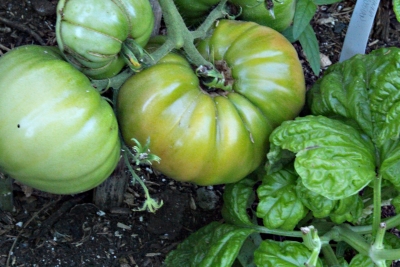 But the scene is not as rosy as it should be, literally, because too many of the tomatoes are still green. Again, other local gardens mimic my experience. How are your tomatoes doing this year?
But the scene is not as rosy as it should be, literally, because too many of the tomatoes are still green. Again, other local gardens mimic my experience. How are your tomatoes doing this year?
Day after day of bright sunny, weather and moderate temperatures should have promoted ripening. Then again, day after day of rainy weather last month might have retarded it. At any rate, in gardening and farming, you can’t go wrong blaming the weather.
HOT DAYS, BUT PREPARING FOR FALL
/7 Comments/in Fruit, Gardening, Planning, Vegetables/by Lee ReichIgnoring My Gut
Like other parents, I don’t hold back preparing for fall just because of hot, sun-drenched sunny days. But my preparations don’t entail trips to the store for notebooks, pencils, rulers, and other school gear. My daughter is old enough to gear up for herself. Instead, I’m preparing for a garden that becomes lush with ”cool weather” vegetables just as tomatoes, peppers, okra, and other warm weather vegetables are fading OUT.
Much of gardening entails NOT going with your gut. If I went with my gut, I’d be planting more tomatoes and sweet corn and, perhaps, if I was really going with my gut, even banana trees on today’s ninety plus degree, bright, sunny, humid day.
Although tomatoes, peppers, and cucumbers presently have more appeal, fall vegetables will have their day. I have to remind myself how a lowering sun and cooler weather make more appealing the lush green leaves of cabbages, brussels sprouts, endive, lettuce, kale, celery, and, below ground, radishes, turnips, carrots, and celeriac. And anyway, I’ll have no choice because summer vegetables will have waned by then.
That lush fall garden, almost like a whole new garden, comes about only if I do something about it now!
To Every Thing There is a Season, a Time to Plant, A Time to…
Timing is (almost) everything for a productive fall garden. Planted too early, some leafy fall vegetables bolt — send up tough seed stalks — because of heat and long days. Right now, I’m sowing turnips and winter radishes, the especially tasty varieties Hakurei and Watermelon respectively. Among leafy, salad vegetables, lettuce, mustard (the variety Mizuna), and endive, with repeated sowing of lettuce every weeks until early September.
It’s still a too early for spinach, arugula, mâche, short season Chinese cabbages, and spring radishes. Some time later this month would be about right for these vegetables. My book, Weedless Gardening, gives a detailed schedule for when to plant what vegetables for specific regions.
For a truly bountiful fall garden, more advance planning was needed. For instance, I won’t be harvesting brussels sprouts until October, but for sprouts lining stalks three to four foot tall, I sowed those seeds indoors in March. Celery and celeriac seed got sprinkled in mini-furrows in seed flats way back in early February.
Zero Tolerance for Weeds, Almost
Almost as important as timing for my fall garden is weeding. The enthusiasm of many gardeners peaks in spring and then slowly wanes as summer heats up. Not mine.
Every time I see a lambsquarters weed, the thought of the eventual 100,000 seeds it might sow prompts be to bend down and yank it out. Same goes for purslane plants, whose seeds remain viable in the soil for decades. And spotted spurge; each plant not only spreads thousands of seeds, but those seeds sprout quickly to mature new plants that make even more baby, then adult, spotted spurges. How could I bring myself not to pull these weeds. (Yes, I know, lambsquarters and purslane are edible — if you like their flavor.)
With weeds kept in check through June, much less effort has been needed to maintain the status quo. Mostly, this is because drier weather has limited weed growth and seed germination, and because any watering in my garden is with drip irrigation. Rather than coaxing weed growth in pathways (and also wasting water), as do sprinklers, drip irrigation pinpoints water to garden plants.
Fresh Figs Bring Me back to Summer
Back to enjoying summer . . . we’ve been enjoying the first crop, known as the breba crop, of figs from the ‘Rabbi Samuel’ fig tree espaliered in the greenhouse.
Most fruit plants bear fruits on one-year-old, or older, stems. Figs, depending on the variety, can bear on one-year-old stems, on new, growing shoots, or on both one-year-old stems and on new, growing shoots. ‘Rabbi Samuel’, I have found, bears on both.
The tree is trained to a T, with two horizontal arms growing in either direction from atop an 18” high trunk. New shoots spring up vertically at about 6 inch spacing along the arms. Late each fall, I cut all those shoots almost back to the arms to make room for and coax new fruiting shoots for the following year.
The stubs left after cutting back the season’s shoots are one year old, and that’s where brebas have been borne. This fall, I’ll leave some a few inches long, for a larger breba crop next July; the next year I’ll shorten them more drastically and leave others a few inches long; and so on, year after year.
The main crop, on new, growing shoots, should begin ripening not to long after the last of the brebas have been harvested. With sufficient sunlight and a bit of supplemental heat in the greenhouse, harvest of the main crop will continue until November’s days grow too short, soothing the transition from the summer to the fall garden.

